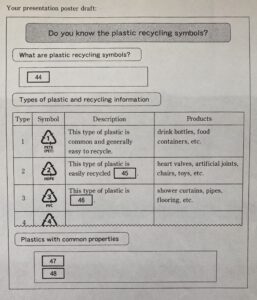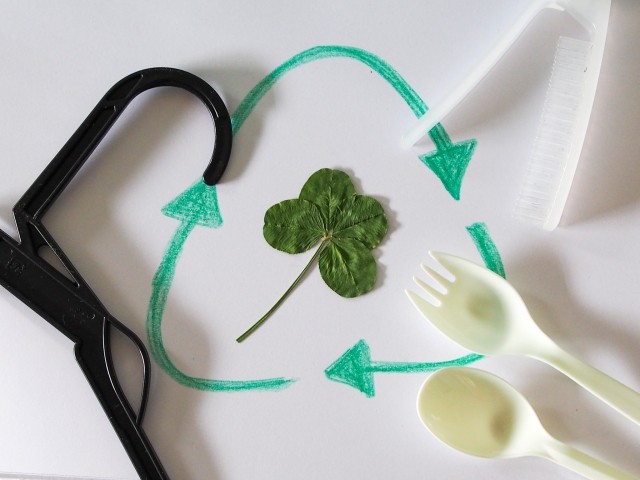第6問 B の模範解答・・・問題をやってから確認しましょう
それでは、先に模範解答です。
解答・・各3点
問1-2 問2- 2 問3ー1 問4ー [ 3・4]※順不同
第6問 B の解説
第6問 B では、「あなた」は”環境を守るために私たちが知っておくべきこと” という
テーマで科学的なプレゼンの大会のためのポスターの準備をしている生徒のグループの
一員です。そのポスターを作るために次の流れを使っています。
B You are in a student group preparing a poster for a scientific presentation
contest with the theme “What we should know in order to protect the
environment.” You have been using the following passage to create the poster.
|
Recycling Plastic ❶ The world is full of various types of plastic. Look around, and you will see |

|
❷ So, what do these numbers mean? One group (numbers 2,4, and 5) is ❸ High-density Polyethylene is a recycle-type 2 plastic and is commonly ❹ Now let us look at the second group, Types 1, 3, 6, and 7. These are more ❺ Currently, only about 20% of plastic is recycled, and approximately 55% |

問1 Under the first poster heading, your group wants to introduce the plastic
recycling symbols as explained in the passage. Which of the following is the
most appropriate?【 44 】
① They are symbols that rank the recyclability of plastics and other
related problems.
② They provide information on the chemical make-up and recycling options
of the plastic.
③ They tell the user which standards organization gave them certificates
for general use.
④ They were introduced by ASTM and developed by the Society of the
Plastics Industry.
問2 You have been asked to write descriptions of Type 2 and Type 3 plastics.
Choose the best options for【 45 】and【 46 】.
Type 2 【 45 】
① and commonly known as a single-use plastic
② and used at a wide range of temperatures
③ but harmful to humans
④ but unsuitable for drink containers
Type 3 【 46 】
① difficult to recycle and should not be burned in the yard
② flammable; however, it is soft and cheap to produce
③ known to be a non-toxic product
④ well known for being easily recyclable
問3 You are making statements about some plastics which share common
properties. According to the article, which two of the following are
appropriate? (The order does not matter.) 【 47 】【 48 】
① Boiling water (100℃) can be served in Type 1 and Type 6 plastic containers.
② It is easy to recycle products with Type 1, 2, and 3 logos.
③ Products with the symbols 1, 2, 4, 5, and 6 are suitable for food or drink
containers.
④ Products with Type 5 and Type 6 markings are light in weight.
⑤ Type 4 and 5 plastics are heat resistant and are widely recycled.
⑥ Type 6 and 7 plastics are easy to recycle and environmentally friendly.
それでは、詳しく問題を見ていきます。
解説 – 「環境を守るために私たちが知るべきこと」のプレゼン
👉どの問題も「ある設定」のもとでの「英文読解」なので、
一番最初にするべきことは、その「設定」をしっかり把握することです。
▶︎その「設定」が、問題の最初に説明されているので、
まずは、それをしっかりと確認します。
【設定】
B You are in a student group preparing a poster for a scientific presentation
contest with the theme “What we should know in order to protect the
environment.” You have been using the following passage to create the poster
[登場人物]
・「あなた」
[設定状況]
[1] 👉黄色いアンダーラインから
– 「環境」問題をテーマとしたプレゼンのコンテストのためのポスターを用意しています。
[2]👉そのポスターを作るために
– 「次のような流れ」を使っているところだ
となっています。
▶︎この「設定」の下にあるのが、
その「プレゼン内容」とそのプレゼンに必要な「ポスターの下書き」となるわけです。
👉ここまでを、
理解した上で、「先に」問題の選択肢を簡単にチェックしてから、設問の後の
「プレゼン内容」とその後にある「ポスター下書き」をチェック
したほうが良いようです。
👉「プレゼン内容」の記事を見ると
タイトルは “Recycling Plastic (プラステックのリサイクル)” で
サブタイトルは “What You Need to Know (知っている必要のあること)” と
なっています。
👉「ポスターの下書き」を見ると
タイトルは “Do you know the plastic recycling symbols? (プラステックのリサイクルマークを知っていますか)” となっています。
問1について
【選択肢のチェック】
問1 Under the first poster heading, your group wants to introduce the plastic
recycling symbols as explained in the passage. Which of the following is the
most appropriate?【 44 】
① They are symbols that rank the recyclability of plastics and other
related problems.
② They provide information on the chemical make-up and recycling options
of the plastic.
③ They tell the user which standards organization gave them certificates
for general use.
④ They were introduced by ASTM and developed by the Society of the
Plastics Industry.
【内容】
問1 最初のポスターのタイトルの下で、あなたのグループは流れで説明されるようなプラスティックのリサイクルのマークを導入したい。次のどれが一番適切ですか。【 44 】
① それらはプラスティックのリサイクル性や他の関連する問題をランクづける印です。
② それらはそのプラスティックの化学成分やリサイクル方法の情報を提供する。
③ それれは使用者にどの標準化団体が人々に一般利用の証明書を与えたのかを教える。
※standards organization:標準化団体
④ それらはASTMにより導入され、プラステック工業協会により発展された。
※ASTM:American Society for Testing and Materials「米国試験材料協会」
※Society of Plastics Industry:米国プラステック工業協会
👉「ポスター下書き」を見ると…
What are plastic recycling symbols? というタイトルの下に
【 44 】があるので、
「プラスティックのリサイクルのマークが何であるか」を
簡単に答える内容が、そこに入る解答のようです。
▶︎「プレゼン内容」の❶ – 1段落目を見ると…
この「リサイクル」のマークの説明がなされています。
このマークについては、次のように簡潔に説明されています。
| ❶ 〜 Recycling symbols provide important data about the chemical composition of plastic used and its recyclability. 〜 ◎リサイクルのマークは使われているプラスチックの化学構成物質とそのリサイクルの再生の 仕方についての重要なデータを提供します。 |
👉この内容に近い、選択肢を選ぶと正解が
② They provide information on the chemical make-up and recycling
options of the plastic. となります。【 44 】
※【 44 】②
問2について
【選択肢のチェック】
問2 You have been asked to write descriptions of Type 2 and Type 3 plastics.
Choose the best options for【 45 】and【 46 】.
Type 2 【 45 】
① and commonly known as a single-use plastic
② and used at a wide range of temperatures
③ but harmful to humans
④ but unsuitable for drink containers
Type 3 【 46 】
① difficult to recycle and should not be burned in the yard
② flammable; however, it is soft and cheap to produce
③ known to be a non-toxic product
④ well known for being easily recyclable
【内容】
問2 あなたはタイプ2とタイプ3のプラスティックの記述を書くをように頼まれて
います。【 45 】と【 46 】に対する最も適切な選択肢を選びなさい。
タイプ2
① そして使い捨てのプラステックとして一般的に知られている
※single-use「使い捨て」
②そして広範囲の温度で使われる
③しかし人に対して有害
④しかし飲み物の入れ物には適切ではない
タイプ3
①リサイクルは難しく、庭で燃やされるべきではない
②可燃である; しかしそれはソフトで生産するのに安価である
③無害な製品であると知られている
④簡単にリサイクルできることでよく知られている
👉まずは、「ポスターの下書き」を見ると
Type 2 と Type 3 の部分は下記のようになっています。(マーク省略)
| Type | Symbol | Description | Products |
| 1 | 省略 | This type of plastic is easily recycled【 45 】. | heart vales, artificial joins chairs, toys, etc. |
| 2 | 省略 | This type of plastic is【 46 】. | shower curtains, pipes flooring, etc. |
👉まずタイプ2についての記述を「プレゼン内容」から探します。
❷の段落にで関連する部分は下記の通り
・One group ( number 2, 4, and 5) is considered to be a safe for the human
body.
| ◎1つのグループ(2番、4番、5番)は人間の体に対して安全であると考えられている。 |
❸段落の部分では…
・High-density Polyethylene is a recycle-type 2 plastic and is commonly
called HDPE. It is non-toxic and can be used in the human body for heart
valves and artificial joints. It is strong and can be used at temperatures as low
as -40℃ and as high as 100℃. HDPE can be reused without any harm and
is also suitable for beer-bottle cases, milk jugs, chairs, and toys. Type 2
products can be recycled several times.
| ◎高密度ポリエチレンはリサイクルのタイプ2のプラスステックで一般的には HDPE と呼ばれます。 それは無害で心臓の弁や人工的な関節として人間の体の中で使われます。それは頑丈で-40℃という低温から 100℃という高温まで、使えることができます。HDPE は害がなく再利用できるし、ボールのボトル、牛乳の入れ物、椅子やおもちゃにも適しています。タイプ2の製品は数回リサイクルすることが出来ます。 |
👉この内容と選択肢からすると、正解は
② and used at a wide range of temperatures となります。【 45 】
※【 45 】②
This type of plastic is easily recycled and used at a wide range of temperatures.
👉同じようにタイプ3についての記述を「プレゼン内容」から探します。
❷の段落にで関連する部分は下記の通り
・while the other group (numbers 1, 3, 6, and 7) could be problematic in
certain circumstances.
| ◎一方他のグループ(1番、3番、6番と7番) はある環境の元では問題がある可能性を含む。 |
❹段落の部分では…
・Now let us look at the second group, Type 1, 3, 6, and 7. These are more
challenging because of the chemicals they contain or the difficulty in recycling
them.
| ◎次は2番目のグループ、タイプ1、3、6と7を見ましょう。これらはそれらが含む化学物質やリサイクル する上での困難さのためより挑戦的なものです。 |
・PVC, Type 3 is thought to be one of the least recyclable plastics known.
It should only be disposed of by professionals and never set fire to at home or
in the garden. Type 3 plastic is found in shower curtains, pipes and flooring.
| ◎タイプ3である、PVCは、知られている中で最もリサイクルされていないプラステックの1と考えられ ています。それは専門家によってのみ処理され、決して自宅や庭で燃やされるべきではない。タイプ3の プラスティックはシャワーカーテンや、パイプ、フローリングなど使われます。 |
👉この内容と選択肢からすると、正解は
① difficult to recycle and should not be burned in the yard となります。
【 46 】
This type of plastic is difficult to recycle and should not be burned in the yard.
問3について
【選択肢のチェック】
問3 You are making statements about some plastics which share common
properties. According to the article, which two of the following are
appropriate? (The order does not matter.) 【 47 】【 48 】
① Boiling water (100℃) can be served in Type 1 and Type 6 plastic containers.
② It is easy to recycle products with Type 1, 2, and 3 logos.
③ Products with the symbols 1, 2, 4, 5, and 6 are suitable for food or drink
containers.
④ Products with Type 5 and Type 6 markings are light in weight.
⑤ Type 4 and 5 plastics are heat resistant and are widely recycled.
⑥ Type 6 and 7 plastics are easy to recycle and environmentally friendly.
【内容】
問3 あなたは周知の事柄を共有するプラステックについて発表する予定です。
記事によると、次のどの2つが適切ですか。(順不同です)【 47 】【 48 】
① 100℃に沸騰させたお湯はタイプ1とタイプ6のプラステックの入れ物の
中で対応できる。
② タイプ1、タイプ2とタイプ3のロゴがついている製品はリサイクルしやすい。
③ 1、2、4、5と6のマークがある製品は食べ物や飲み物の入れ物に適している。
④タイプ5とタイプ6のマークの製品は軽量である。
⑤タイプ4とタイプ5のプラステックは耐熱で広くリサイクルされる。
⑥タイプ6とタイプ7のプラステックはリサイクルしやすく、環境にやさしい。
👉記事の内容と合うものを探す問題です。
これは、1つ1つの内容をチェックしていきましょう。
① Boiling water (100℃) can be served in Type 1 and Type 6 plastic
containers.
▶︎そのプラステックが耐熱かどうかを確認しましょう。
◎タイプ1について – ❹段落にそれに関する表記があります。
| ❹ Recycle-type 1 plastic is commonly known as PETE, and is used mainly in food and beverage containers. PETE containers – or PET as it is often written in Japan – should not be heated above 70℃ as this can cause some containers to soften and change shape. |
※タイプ1の入れ物は、飲食の入れ物ととして使われてるが、70℃より高い温度で
温められると柔らかくなり形が変わる、とあるので当てはまりません。
◎タイプ6について – ❹段落にそれに関する表記があります。
| ❹ Type 6. Polystyrene (PS) or Styrofoam as it is often called, is hard to recycle and catches fire easily. However, it is cheap to produce and lightweight. It is used for disposable drinking cups, instant noodles containers, and other food packaging. |
※タイプ6はリサイクルしづらく、簡単に発火する。それは使い捨ての飲料カップや
インスタントヌードルの入れ物、その他の食べ物にパッケージとして使われる、
とあるので、100℃のお湯にも耐えられるようです。
▶︎ここから、①は❌となります。
② It is easy to recycle products with Type 1, 2, and 3 logs.
▶︎タイプ1、2、3がリサイクルしやすいものか確認しましょう。
◎タイプ1について – ❹段落に下記のような表現があります。
| ❷ Uncontaminated PETE is easy to recycle and can be made into new containers, clothes or carpets, but if PETE is contaminated with Polyvinyl Chloride (PVC), it can make it unrecyclable. |
※汚染されていないPETEは、リサイクルしやすいが、汚染されたものは
リサイクルできないと記されてます。
◎タイプ2について – ❸段落に次のように記されています。
| ❸ Type 2 products can be recycled several times. |
※タイプ2の製品は、数回リサイクルされるとあるので、リサイクルしやすい
ものであるということです。
◎タイプ3について – ❹段落に下記のようにあります。
| ❹ PVC, Type 3, is thought to be one of the least recyclable plastics known. |
※タイプ3の製品は、最もリサイクルされないプラステックの1つだとあるので、
リサイクルしにくいものだと解ります。
▶︎ここから、②は❌となります。
③ Products with the symbols 1, 2, 4, 5, and 6 are suitable for food or
drink containers.
▶︎1、2、4、5と6のマークがある製品が飲食の入れ物に適しているか確認!
◎❷段落目に次のような表記があります。
| ❷ One group (numbers 2, 4, and 5) is considered to be safe for the human body. |
※2、4、5のマークの製品は大丈夫のようです。
◎1のマークについては – ❹段落をチェック!
| ❹ Recycle-type 1 plastic is commonly known as PETE, and is used mainly in food and beverage containers. |
※マーク1のものは、主に食べ物や飲み物の入れ物として主に使われています。
| ❹ It is used for disposable drinking cups, instant noodle containers, and other food packaging. |
※6に関する製品は、飲食関係の入れ物、パッケージに使われいます。
▶︎これから、③は⭕️となります。
④ Products with Type 5 and Type 6 markings are light in weight.
▶︎タイプ5と6の製品が軽量のものか確認しましょう。
◎タイプ5について – ❸段落に表記があります。
| ❸ It is light, non-stretching, and has a high resistance to impact, heat, and freezing. |
※タイプ5の製品は、軽量です。
◎タイプ6について – ❹段落に書かれています。
| ❹ However, it is cheap to produce and lightweight. |
※タイプ6のものは、軽量です。
▶︎これから、④は⭕️となります。
⑤ Type 4 and 5 plastics are heat resistant and are widely recycled.
▶︎タイプ4と5のプラステックが耐熱性があり、広くリサイクルされているか、
確認しましょう。
◎タイプ4について – ❸段落に次のような表記があります。
| ❸ Currently, very little Type 4 plastic is recycled. |
※現在は、タイプ4のプラステックはほとんど使われていません。
◎タイプ5について – ❸段落に次のような文があります。
| ❸ Only 3% of Type 5 is recycled. |
※タイプ5の3%だけがリサイクルされています。
▶︎ここから、⑤は❌となります。
⑥ Type 6 and 7 plastics are easy to recycle and environmentally friendly.
▶︎タイプ6と7のプラステックはリサイクルしやすく環境にやさしいのか、確認!
◎タイプ6について – ❹段落をチェック!
| ❹ Type 6, 〜, is hard to recycle and catches fire easily. |
※タイプ6のものは、リサイクルするのが難しいとあります。
◎タイプ7について – ❹段落を見ましょう。
| ❹ Type 7 plastics are difficult to recycle. |
※タイプ7のプラステックは、リサイクルが難しいとあります。
▶︎ここから、⑥は❌となります。
👉この結果、正解は、
③ Products with the symbols 1, 2, 4, 5 and 6 are suitable for
food or drink containers.
④ Products with Type 5 and Type 6 markings are light in weight.
の2つとなります。【 47 】【 48 】
※【 47 】【 48 】③ ④
| Type 1:PETE (Polyethylene Terephthalate ) 日本では PETE <ポリエチレンテレフタレート> Type 2:HDPE (High-density Polyethylene) <高密度ポリエチレン> Type 3:PVC (Polyvinyl Chloride) <ポリ塩化ビニル> Type 4:LDPE (Low-density Polyethylene) <低密度ポリエチレン> Type 5:PP (Polypropylene) <ポリプロピレン> Type 6:PS (Polystyrene) or Styrofoam <ポリスチレン> Type 7:- acrylics, nylons and polycarbonates <その他のプラステック – アクリル, ナイロン, ポリカーボネート> |

これで2022年の大学共通テストの解説終了です。



コメント